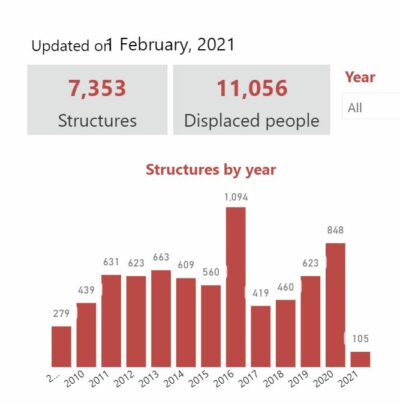The United Nations Office for the Coordination of Humanitarian Affairs In the Occupied Palestinian Territory (OCHA-OPT): The figures below reflect the demolition of Palestinian-owned structures and the resulting displacement of people from their homes across the West Bank since 2009. Together with other policies and practices, the threat of destruction of homes and sources of livelihood contributes to the generation of a coercive environment pressuring people to leave their areas of residence.
Click, tap or hover over charts to interact with data or click here for more breakdowns(link is external).
The figures presented here are based on visits that OCHA carries out as part of an initial assessment of people’s humanitarian needs. They are saved in a database that informs multiple agencies’ decisions on humanitarian assistance they provide, thereby allowing timely and targeted responses. Typically, demolitions are reflected in this page within 48 hours of the incident.
Please note
- Demolished structures may be residential, livelihood-related, service-related or part of infrastructure. Residential structures – homes, certain parts of homes, apartment buildings etc. – may be inhabited (in which case their demolition typically results in displacement) or uninhabited (for example, if they are under construction). Livelihood structures may include shops, animal shelters, walls, warehouses and more. Structures that are part of infrastructure may include water pipes, roads, network facilities, among others.
- Depending on the circumstances and the type of structure, incidents referred to here as “demolitions” may include dismantlement, confiscation or sealing off of structures or parts of structures.
- Figures include incidents where structures were demolished by either the authorities or the owners, who were forced to do so by the authorities.
- Demolitions are typically carried out due to lack of Israeli-issued permits, which are nearly impossible to obtain, but in some cases the circumstances are different, including punitive demolitions and demolitions carried out as part of military activities.
- “Affected people” refers to those whose livelihood has been affected by the demolition without being displaced. “Displaced people” and “affected people” are mutually exclusive.
- In some cases, the same person has been displaced more than once. For example when they rebuilt their demolished home and had their second home also demolished. These are counted as displaced for each incident in which they were displaced. Similarly, “affected people” may include replication where the same people have been affected by multiple demolition incidents.

